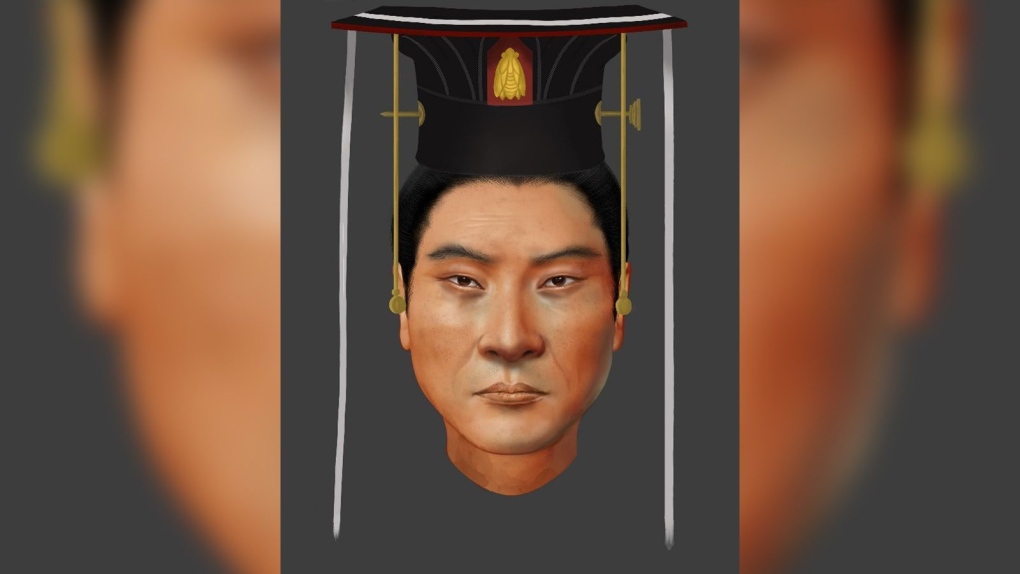Ancient DNA recovered from the remains of a sixth century Chinese emperor who ruled during the country’s dark ages has shed some light on what the leader may have looked like.
Emperor Wu ruled China as part of the Northern Zhou dynasty from 560 to 580 and is credited with unifying the northern part of ancient China during a particularly chaotic period.
Archaeologists found his tomb in northwestern China in 1996. In a study published Thursday in the journal Current Biology, researchers analyzed genetic material from his remains, which included a nearly complete skull. They gleaned information about his appearance, health and ancestry.
The emperor belonged to a little studied nomadic group called the Xianbei that lived in an area that today is Mongolia and northern and northeastern China. The analysis of the genome sequenced from the DNA suggested Wu had brown eyes, black hair and dark to intermediate skin color.
“Some scholars said the Xianbei had ‘exotic’ looks, such as thick beard, high nose bridge, and yellow hair,” said Shaoqing Wen, study coauthor and an associate professor at Fudan University in Shanghai, in a news release. “Our analysis shows Emperor Wu had typical East or Northeast Asian facial characteristics.”
The authors said they hoped ancient DNA might shed light on Wu’s cause of death. The emperor died suddenly at age 36, according to the study. Explanations for his demise put forward in historical texts include illness and deliberate poisoning.
The team couldn’t find any definitive evidence of why he died. However, the researchers said they uncovered a genetic susceptibility to stroke, which could explain some of the symptoms that historians have attributed to Wu: eyelid drooping, blindness and an affected gait.
Archaeologists are increasingly applying ancient DNA techniques to tease out information from bones, teeth, artifacts and cave dirt.
Wu facial reconstruction
The team used genetic information from the remains, including Wu’s skull, to imagine what he would have looked like, creating a 3D facial reconstruction that humanizes a little-known figure.
“The study … offers intriguing insights into the historical figure of Emperor Wu, with the facial approximation presented appearing convincingly realistic,” said Tobias Houlton, a lecturer in craniofacial identification and forensic imaging at the University of Dundee who has worked on facial reconstructions of historical figures, via email. He was not involved in the study.
“(Skin, hair and eye) colour details are notably not possible to predict from skeletal remains alone, making genetic analysis an insightful tool.”
However, the study did not give enough detail about other morphological variables such as the thickness of the skin, muscle and fat that envelop the facial bones, eyeball placement and projection, eyebrow shape, nose width, and lip height, factors which can be included in a facial reconstruction, Houlton said.
The Xianbei: A rarely studied group
More interesting than the emperor’s appearance was his Xianbei ancestry, said Jeong Hoongwon, an associate professor at Seoul National University’s School of Biological Sciences. Jeong, who wasn’t part of the new research, has studied the Xiongnu, a separate nomadic empire that pushed China to build its Great Wall.
The genetic analysis showed that Emperor Wu intermarried with ethnically Han Chinese, China’s dominant ethnic group today.
“I think it is important to understand the elite group he belonged to, which arose as a merger of Xianbei and local Han elite groups, rather than himself,” Jeong said via email. “This group has been rarely studied in genetics and this study provides one of the first such cases.”
Jeong compared the Xianbei and Xiongnu to Germanic tribes such as the Franks and Goths that occupied parts of the Roman Empire as it collapsed.
He said it was notable that Emperor Wu had a relatively high percentage of ancestry from a group known as ancient North Asians, given that the Xianbei had interacted with the dominant Han Chinese for several centuries by that point.
Wu ruled during a period of Chinese history often deemed a “dark age of chaos,” with dynasties rising and falling in quick succession, said Bryan Miller, assistant professor of Central Asian art and archaeology at the University of Michigan. Miller, who wasn’t involved in the study, said it was a period of history that warranted more study.
“It’s interesting to see the genetic study, but none of the findings of this genetic study are surprising at all,” Miller said. “We know the big rulers were intermarrying, but what about the political substrata — to what degree were lower elites allowed to intermarry?
“I think that’s where genetics could really start to tell an interesting story.”


